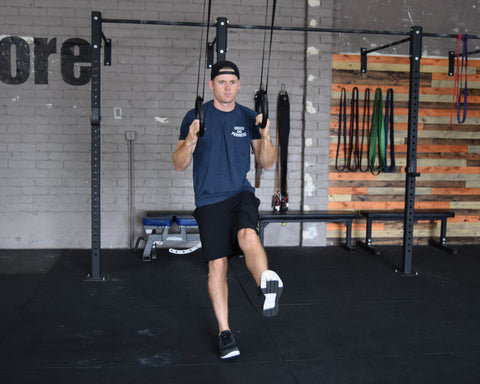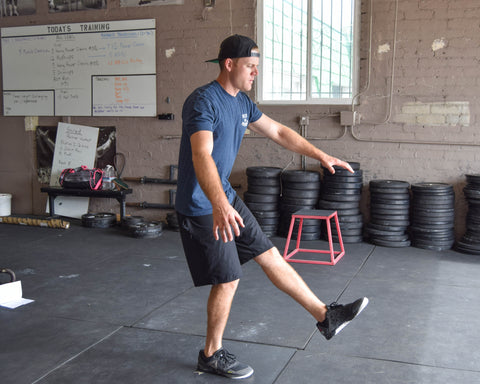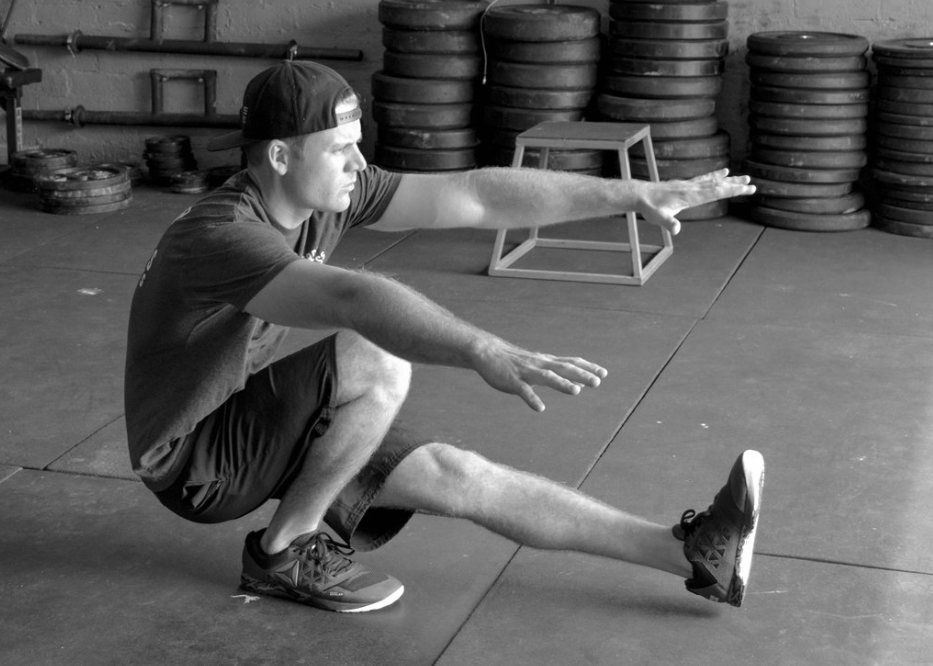Guest post by Will Safford, a Certified Strength and Conditioning Coach who trains under Andre Galvao in San Diego, CA. He received is purple belt in December of 2013 and competes occasionally in the heavyweight division. Will specializes in mobility training, injury prevention, and kettlebell strength and conditioning. Visit his website at www.ironwillathletics.com and check out his new e-book about Strength Training for BJJ:Strength Without Size.
When it comes to improving your strength and conditioning for sports performance the options are almost limitless. Rare, however, is it to find an exercise that will improve your strength, stability, mobility, and prevent injury with just one move. As Jiu Jitsu fighters we need all of these qualities. And the ability to move your own bodyweight is essential. That’s why the Single Leg Squat and its variations should be on the top of your list for supplemental exercises.
If you freeze frame a Jiu Jitsu match you’ll see a one-legged squat pattern repeat itself continuously – passing from Reverse De La Riva, playing Spider Guard, crouching low in X-Guard, etc. Rarely do we find ourselves planted firmly on both feet, so having the strength, endurance, and balance to attack and defend from just one leg, in different planes of motion, is a top priority. Over this series we’ll cover the benefits of the Pistol and Cossack Squats, and their regressions and progressions. Today we start with the Pistol Squat.
SINGLE LEG STRENGTH
The big lifts like the Squat and Deadlift are phenomenal for building serious strength. If you’re constantly training exercises on two feet, however, you may develop strength asymmetries between your limbs. Normally, you’ll have a dominant limb that will contribute more during an exercise. This limb will not only contain more muscle mass, but the neurological connections between the muscles to the spinal cord will be stronger as well.
That’s why it’s important to train single leg exercises. There are many options for this, however none are as demanding as the Pistol Squat. Exercises like Lunges and Split Squats will surely improve single leg strength, but most of these are performed with assistance of the non-working leg. The non-working leg provides added stability, and neither of these single leg variations demand the same range of motion as the Pistol.
When you’re on just one leg, with one point of contact, at the rock bottom of a Pistol Squat, the fullest expression of single leg strength will be tested. Typically, there will be an immediate and blaring asymmetry between your left and right. And unless you’ve spent considerable time exercising on just one leg, you probably won’t hit your first Pistol from the get go.
Pistol Squats will give you the single leg strength to stand up from rock bottom. How often do you find yourself on one leg on the mat? Rarely are we pushing evenly through both legs while passing or playing guard. Pistols will give you the strength to push advancing passers away, finish your spider sweep with authority, and stand up from compromised positions like 50/50 or Single Leg X.
MOBILITY
Mobility is finally getting the attention it deserves, as it’s the root of fluid movement, injury prevention, and optimal performance. If you lack mobility in your ankles, hips, or spine you likely won’t be able to perform a full Pistol. This type of one-legged squat demands you have near full expression of your joints. Something enormously valuable while grappling.
The Pistol Squat is also a good way to test your mobility on a given day. If you have trouble reaching the bottom position, even with assistance, you need to do some work on your ankles and hips. Once you’ve earned the ability to do a full Pistol, performing a few unloaded will actually mobilize these areas for you. One of the added benefits of the exercise. In turn, it becomes a useful warm-up exercise on top of its strength building ability.
BALANCE AND STABILITY
We’ve all been caught on one leg, fending off the single-leg attempt, stuck in X-Guard or whatever situation on the mat. In this position you’re vulnerable and facing the inevitability of a disadvantageous position. Balance and stability are the qualities that can relieve you from the impending doom. The Pistol Squat provides the practice necessary to improve your balance while strengthening your leg and stabilizing your knee and ankle joints.
Undoubtedly, your core is hard at work when performing a squat on one leg. It must contract hard to balance your upper body over a single moving limb while changing levels. The eccentric or lowering phase of the Pistol will provide the greatest benefits to joint stability and overall balance. So developing this portion while learning the Pistol will pay dividends in the long run.
INJURY PREVENTION
One of the first signs of a potential injury is an asymmetry between the body’s halves, be either front to back, side to side, or top to bottom. The asymmetry can be strength, mobility, or stability based, and the Pistol Squat will quickly identify which ones are lacking from leg to leg.
Shoring up these areas with a healthy dose of single leg squats will help prevent injuries from a limb to limb perspective, but also as mentioned, provide the mobility and stability to combat future aches and pains.
PISTOL PROGRESSIONS
If you’ve never done a Pistol Squat use the following progressions to get you there. To gain mobility, break down the tissue on the back of your calf, just above your Achilles Tendon, with a lacrosse ball or foam roller to loosen up your ankles. Then loosen your hips with mobility drills like the 90/90 Hip Switch and or Prying Goblet Squat.
First, you should be able to do a full depth Goblet Squat before attempting the Pistol Squat. Then work on a full depth squat with feet together.


Next, work on your stability and single leg strength with Eccentric Step Ups. This is a good way to develop the prerequisite strength without the mobility demands of the full Pistol.




Then, move on to the Box Pistol and move to a lower and lower box to develop range of motion.




Work the full range of motion of the Pistol with Assisted Pistol Squats.





Finally, perform counter weighted Pistols and full Pistol Squats.






















